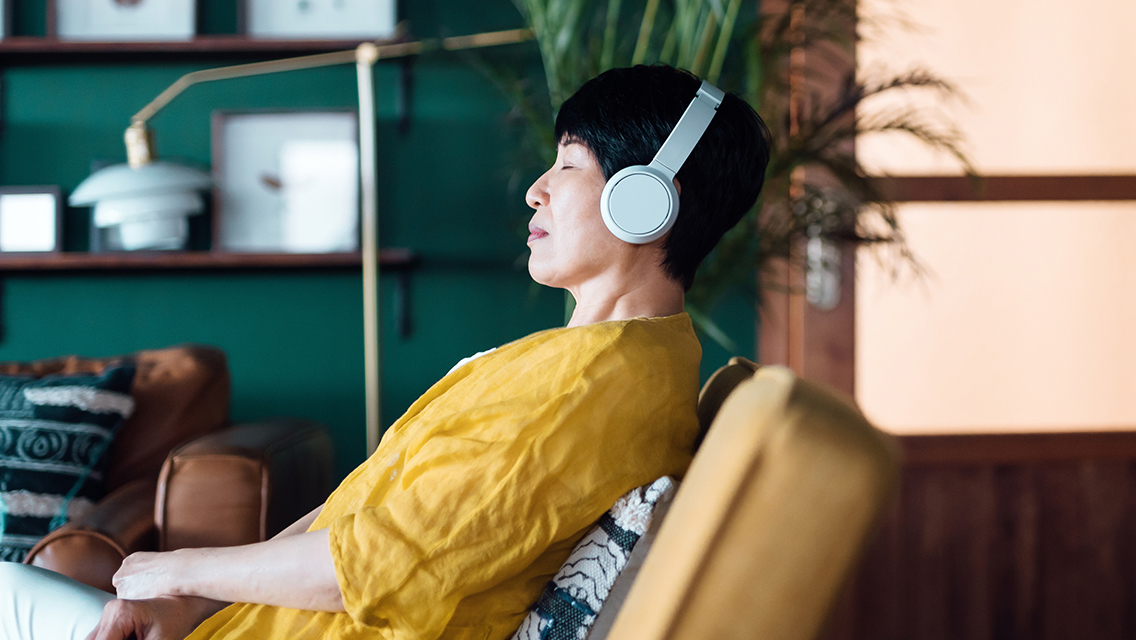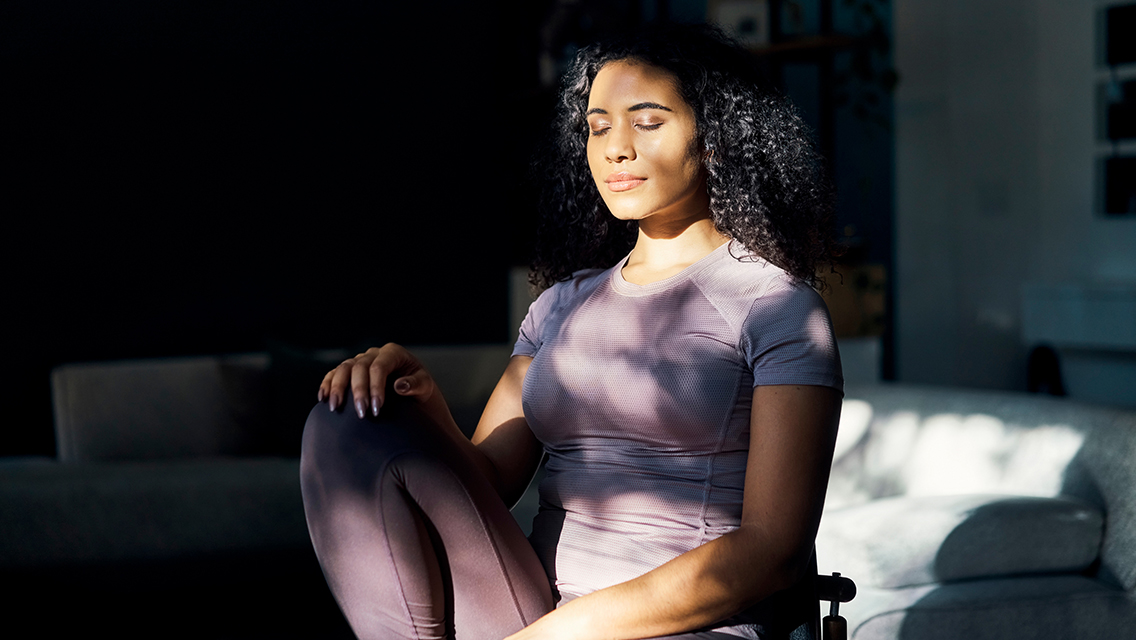Explore this article:
The practice of deliberately imagining positive outcomes is nothing new. It’s likely been around for as long as humans have been able to conceive realities beyond the five senses. Plato’s Allegory of the Cave, for instance, is an image-centered allegory from ancient Greece that emphasizes the value of seeing beyond what is before us.
Today, sports psychologists and coaches routinely work with athletes to visualize techniques and success. The record-breaking Olympic swimmer Michael Phelps has used guided imagery throughout his career to improve his performance. Other Olympians, including Canadian bobsledder Lyndon Rush and American skier Emily Cook, say training in their minds has been key to their success.
Our innate ability to imagine is at the core of guided imagery, a cost-effective tool that can support any number of goals, including relaxation, performance, healing, and more.
Other names for it include “guided meditation” and “mental rehearsal.” It’s a cousin to hypnosis, and a wide range of research studies have shown that it can improve outcomes for a variety of conditions, including depression, anxiety, PTSD, and certain inflammatory diseases.
It’s been promoted by major hospitals as a helpful support during cancer treatment and a useful preparation for undergoing surgery and giving birth.
Guided imagery may sound abstract, but the practice itself is straightforward. What’s more, it’s largely free, and something we can do ourselves — anywhere, anytime — with a pair of headphones and time enough to close our eyes, relax, and listen.
The Brain and Body in Conversation
Guided imagery engages the brain’s ability to evoke pictures and other sensory experiences. Psychotherapist Belleruth Naparstek, ACSW, BCD, is a key figure in the development of the practice, and she describes it as a “deliberate, productive daydream.”
While meditation and other mindfulness techniques often encourage detachment from a specific outcome, guided imagery involves a goal. It may be specific, like lowering one’s race time, or somewhat diffuse, like overcoming the effects of PTSD.
Naparstek believes most of us have engaged in some version of guided-imagery practice all our lives, whether we know it or not. She notes how children learn to internalize images of their caregivers so they can picture them when they’re absent, a key component of self-soothing.
When you picture yourself relaxing comfortably in your bed after a successful surgery, making the perfect tennis shot, or successfully completing an important project, you’re doing some version of the same thing — internalizing the image of a desired outcome, which may also replace a fear-based image.
While meditation and other mindfulness techniques often encourage detachment from a specific outcome, guided imagery involves a goal.
Seeing something in our minds makes a difference, because our bodies appear to register imagined experiences in the same way they do lived ones. “[Guided-imagery] therapies take advantage of the connection between the visual brain and the involuntary nervous system,” explains integrative-medicine trailblazer Andrew Weil, MD. “When . . . the visual cortex . . . is activated without receiving direct input from the eyes, it can influence physical and emotional states.”
Our emotional states often reflect the unconscious imprint of past experiences. These subterranean memories routinely influence our daily functioning, as well as our performance at tasks and ability to heal. This is especially true for traumatic memories.
“When we have a traumatic experience, we go into a fight, flight, or freeze response, which effectively takes the brain offline,” says Jane McCampbell Stuart, MA, LMFT, CPCC, a trauma therapist and coach who uses guided imagery in her practice. “That experience ends up being stored in its isolated neural network in the midbrain and doesn’t get integrated into the rest of your overall life story. It can stay there for years until it gets bumped or triggered by something.”
The midbrain is part of the central nervous system, located below the cerebral cortex at the top of the brainstem, and it’s where we process sensory information related to sound, vision, pain, sleep, and arousal. Creating an experience through guided imagery provides the midbrain with an expanded template to work from, enabling us to perceive situations differently than we could before.
“The imaginal experience is like an update to the operating system that smooths out the glitches that were causing distress or difficulty in our relationships,” explains McCampbell. “Once the update has run, it’s hard to remember how things used to feel.”
After a series of negative experiences or trauma, midbrain patterns may get caught in stress reactions such as anger or numbness. As these patterns begin to shift and relax in response to a positive image, the brain can produce sensations of calm and clarity instead. This contributes to the sort of ease in which healing, rest, and relaxed achievement become possible.
“We’re giving you something to focus on so you can keep your busy mind occupied,” McCampbell says of guided-imagery exercises. “You’re keeping the logical, cognitive mind distracted so that the emotional midbrain can do its work.” (For more on healing trauma, see “How Movement Therapy Can Heal Traumatic Stress“.)
Guided Imagery in Action
The most likely explanation for the efficacy of guided imagery is that it seems to ease the nervous system out of crisis mode. Even though it makes intuitive sense that this relaxation would produce better outcomes, the evidence supporting guided imagery is more substantial than we might expect.
“I think it’s particularly useful for any kind of emotional challenge, such as depression or anxiety. It was made to order for coping with anxiety,” explains Naparstek. “It is a beautiful intervention for traumatic stress. . . . It’s very good for helping people recover from stroke or bodily injury. It’s wonderful when used pre-surgically for better outcomes, like reduced length of stay, intraoperative blood loss, use of pain meds, and pre- and post-op anxiety.”
One randomized controlled trial linked guided imagery with less preoperative anxiety, lower post-operative pain, and earlier discharge times after same-day procedures. A 2018 study from the University of California, San Diego, involving a small group of multiple-sclerosis patients, found “improvements in depression, fatigue, and physical and mental quality of life.”
Another randomized controlled trial published in 2015 pointed to the benefits of combining guided imagery with dietary modification to manage irritable bowel syndrome. Guided-imagery practice has even been linked to greater muscular strength in conjunction with weight training, too.
We’re giving you something to focus on. . . . You’re keeping the logical, cognitive mind distracted so that the emotional midbrain can do its work.”
A review of more than 300 randomized controlled trials involving nearly 18,000 individuals concluded that guided imagery improved pain, stroke recovery, anxiety, coping with stress, and sports performance in more than 75 percent of the studies.
Time constraints were cited as a barrier for medical practitioners using guided imagery, but not for patients, who can circumvent the limits of the conventional doctor’s appointment by pursuing its benefits at home on their own.
The research shows how well guided imagery works in conjunction with conventional interventions. It also empowers the patient. “We learn helplessness, and then we’re not aware of the power we have inside to heal ourselves,” says guided-imagery pioneer Emmett Miller, MD.
Although contemporary medical treatment affords many benefits, the self-healing powers of the body and the mind appear well suited to amplify them.
More Than Just an Image
Guided imagery involves more than just imagining visual pictures and scenes. “Some people think you have to be able to visualize, and that’s not necessarily true,” Weil says. “There are other ways to access the mind–body connection for healing.”
Not all of us are visual thinkers; some of us may be more oriented to sound or other senses. Naparstek points out that around 45 percent of people report difficulty evoking detailed imagery, so she endorses a multisensory approach to help create scenes and evoke experiences in the mind.
Emotional sensation is often an integral aspect of a guided-imagery session; you might be encouraged to evoke feelings of gratitude, love, or fulfillment.
“Kinesthetic sensation, and emotional sensation, and all your other senses play into this,” she says. “People think they know whether they’re visual or they’re auditory, but actually we don’t know what combinations will ‘ping’ the best for us. So, it’s good to try them all. I never call it visualization for that reason: It’s misleading.”
Indeed, emotional sensation is often an integral aspect of a guided-imagery session; you might be encouraged to evoke feelings of gratitude, love, or fulfillment. You might imagine feeling the satisfaction of an achievement or feeling relaxed and strong during childbirth.
If you’ve been especially stressed or pressured, you may just cultivate a sense of how it feels when you move through life with greater ease.
Trusting the Mind–Body Connection
For those who remain skeptical of such an abstract process, it’s worth remembering that guided imagery is a low-to-no-stakes investment — it’s easy to approach it as a mental experiment. Find a guided-imagery script on an app and set aside 20 or 30 minutes to relax, listen, and see how you feel.
A great deal of research now supports the idea that the mind and body are a single organism, so what happens with one can be reasonably expected to affect the other — though depending on where we grew up, we may be conditioned to think otherwise. “Guided imagery runs up against the materialistic paradigm that . . . doesn’t see the mind as real and capable of influencing the physical,” notes Weil.
Miller points out that many of us have been influenced by the European philosopher René Descartes and his famous concept of the mind–body split. “There’s little mention of consciousness in Western science,” Miller says. “The past couple of decades we’ve started to dip a toe into the water, but we need to step away from the Cartesian approach to know that everything is integrated, everything is dependent on everything else.”
In the end, philosophers will continue to philosophize about what the mind and body can do. For the rest of us, we need only understand that we may have more power to heal and change than we might think — and that at least some of that power lies right behind our eyes.
How to Use Guided Imagery
One of the notable features of guided imagery is its accessibility. You can listen to scripts with an audio app and a pair of headphones. The popular apps Insight Timer and Headspace both feature large catalogs of guided-imagery audio recordings focusing on a range of outcomes, from general relaxation to supporting health during cancer treatment. The organization Health Journeys, affiliated with psychotherapist Belleruth Naparstek, ACSW, BCD, also provides extensive resources.
Several therapeutic modalities, such as EMDR (eye movement desensitization and reprocessing), routinely make use of guided imagery, so you may also choose to do scripts with a mental-health practitioner. The Academy for Guided Imagery offers a directory of certified practitioners on its website.
When you’re practicing on your own, be sure to give yourself adequate time and space. Carve out quiet, uninterrupted time — almost every recording’s description will include its length, so you can plan accordingly. Find a place that’s as comfortable as possible both physically and emotionally, where you feel safe closing your eyes and relaxing. You might take a few deep breaths and focus on trying to release muscle tension for a minute or so before you begin.
Take a moment beforehand to set an intention. You can silently say to yourself something as simple as I am going to open myself to healing as much as I can in this moment. Then go ahead and relax. There’s no need to judge what you’re experiencing or place expectations on yourself.
Guided imagery is speaking to your unconscious mind as much as to your conscious awareness. That means, in theory, you may not even be paying attention but your awareness beneath the surface is absorbing the message.
Your only task is to release your habitual worries and let yourself imagine what you would like to see and how you would like to feel. Your body will do the rest.
How to Find the Right Guided Imagery for You
Before you select a recording, ask yourself what you want from this experience. Are you preparing for a medical procedure? Recovering from a breakup? Seeking more general relaxation and ease?
You’ll find there are scripts designed for a huge range of experiences, so keep looking until you hit on one that feels right to you. That said, guided-imagery exercises all share the same technique: speaking to your unconscious mind to help improve your conscious life. They’re not a substitute for medical treatment or therapeutic intervention, but they can be a good complement to them.
On that note, steer clear of any guided-imagery experiences that promise miracle cures or encourage you to take any view of yourself or other people that feels discordant or hostile. The goal is to align your unconscious beliefs with your conscious desires for well-being, nothing more or less.
This article originally appeared as “Picture This” in the January/February 2023 issue of Experience Life.





This Post Has 0 Comments